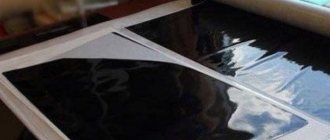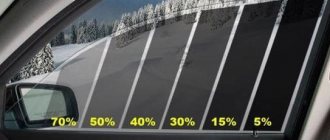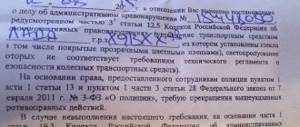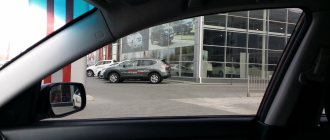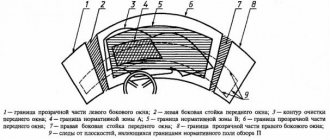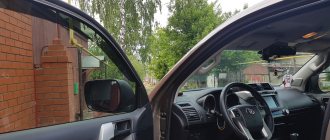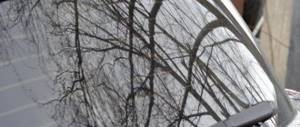Tinting allows you to hide from prying eyes and leave personal belongings and technical devices in the cabin - a radio, video recorder or radar detector. In Russia, tinting of front windows is officially allowed when the light transmittance is at least 70%. Workshops offer a wide range of services and film tinting with much lower throughput. The demand is generated by the fact that it allows the owner to remain incognito. However, there is a penalty for this. What exactly is it and is there a chance to avoid it? Let’s look at it below.
Fine for darkening windows not according to regulations
In 2010, Article 12.5 of the Code of Administrative Offenses was supplemented by Part 3.1, according to which driving a car with windows that do not comply with technical regulations leads to a fine of five hundred rubles (and for repeated violations, the amount does not change). You can pay for it with a 50% discount.
The punishment should not be made more severe at the request of the traffic police, that is, by law you cannot be forced to remove the film on the spot. Although in practice this also happens: the driver signs a resolution, as if agreeing that a violation has taken place, and then the officer demands to “stop illegal actions” (under Article 3 of Federal Law No. 3 “On Police” of 2011) and eliminate the cause violations on site. This is not entirely true, since according to this law the driver only needs to stop operating the vehicle, that is, stop and park, and not remove the film.
Another measure that can be taken against a driver driving a vehicle that is not tinted according to GOST is an inspection of the car and subsequent arrest for 15 days. The basis is disobedience to a police officer under Part 1 of Article 19.3 of the Code of Administrative Offences. However, such a detention or a fine of 500 to 1000 rubles will be illegal, since the requirement to remove the tint is not specified in any law. Consequently, the employee commits arbitrariness under Article 19.1 of the Code of Administrative Offenses and you can write a complaint against him to the traffic police and file an application in court.
In 2021, the State Duma is discussing a bill according to which the punishment for tinting should become more serious. At the same time, this measure will help minimize the situations of lawlessness described above. The fine for the first violation will be one and a half thousand rubles, a second violation will be five thousand rubles, a third will be deprivation of the driver’s license from 2 to 6 months, BUT THIS IS JUST DISCUSSED IN THE STATE DUMA AND HAS NOT COME INTO FORCE!
How not to act
When imposing a penalty for tinting, it is important to draw the right line of action. This will help avoid more serious consequences.
Leave it to chance
If a citizen ignores the requirements of a traffic police officer and continues to use prohibited tinting, this leads to tougher punishment. Penalties are applied to him under paragraph 1 of Article 19.3 of the Code of Administrative Offenses of the Russian Federation, up to and including imprisonment. The number of sanctions imposed on a violator in one day is not limited.
Do not allow light transmittance to be measured
It is impossible to determine this indicator with the naked eye. A special device is required. Any traffic police officer with the appropriate clearance has the right to carry out the procedure.
If the driver interferes with the measurements, he violates current legislation. He is being held accountable under paragraph 1 of Article 19.3. Usually the citizen is taken into custody.
Don't roll up the windows
Some violators, in order to circumvent current legislation and avoid sanctions, resort to this method. They say the mechanism that operates the plexiglass is faulty. So that the inspector does not have doubts about this, citizens deactivate the drive button.
In most cases, such driver actions do not give the desired result. Traffic police officers know about the tricks of violators and know how to detect them. A law enforcement representative has the right to disassemble the door trim to measure the light transmittance of the glass.
Indicate incorrect measurements
This is another common mistake citizens make. The traffic police officer knows exactly how to carry out the procedure. Arguing with the inspector will lead nowhere. If there is a violation of current legislation, he will impose a penalty.
A citizen can only speak about the incorrectness of measurements in court. Typically, drivers refer to the fact that the procedure was carried out in cloudy weather, in the dark, and give other arguments. In fact, people lose most of these cases. Therefore, if a traffic police officer issues a ticket, it is better to pay it.
The easiest way to avoid being fined for tinting is not to use a coating. If a citizen applies film to glass, he should prepare for constant inspections. Sanctions are not applied if light transmission is at least 75%. The material fixed to the windows that satisfies this indicator creates only a slight darkening in the interior, so it can easily be discarded.
Similar articles
- The validity period of the car purchase and sale agreement and...
- How quickly do you receive fines from traffic police cameras?
- Registering a motorcycle: how it goes...
Which option is acceptable?
What car windows should be like is regulated by the following documents:
- GOST No. 32565 “Safety glass for land vehicles”.
- Adj. 8 clause 4 of the technical regulations of the customs union “On the safety of wheeled vehicles”.
- Clause 7.3 Traffic Regulations of the Russian Federation.
These standards impose a number of requirements on car windows:
- Tinting is permitted if the light transmittance of the windshield and side windows of the front row is 70% or more;
- rear windows can be darkened as desired if rear-view mirrors are present;
- the thickness of the dark strip on top of the windshield is up to 140 mm;
- The use of mirror film for all glass without exception is prohibited.
How to use tint correctly so as not to get hurt by the traffic police
To avoid sanctions from law enforcement officers, when fixing the film, you must comply with light transmission standards for:
- frontal plexiglass – 75%;
- front side – 70%.
Related Posts
Amount of fine for lack of technical inspection in 2021
There are no restrictions for rear windows. This allows the use of a coating with any light transmittance. In this case, you cannot use reflective materials or products that completely block the view of the street.
Some drivers hang curtains on their windows instead of film. Their use is permitted only when the vehicle is parked.
Who takes measurements and issues fines?
To record a violation under Part 3.1 of Art. 12.5 of the Code of Administrative Offenses, the luminous transmittance of automobile glass must first be measured. This action can be carried out by:
- traffic police technical supervision is a body that checks whether a car meets technical requirements;
- An employee of the State Traffic Inspectorate (the check is carried out on the basis of Articles 23.3, 26.8, 28.3 of the Administrative Code).
Metering Tools
The luminous transmittance of glass is measured using a taumeter. The most popular companies in the Russian Federation are “Svet”, “Raster”, “Blik+”, “Blik-N” and “Tonic”.
The toilet meter operates from the car cigarette lighter. The meter voltage is usually 12 V with a deviation of no more than 0.6 V (2%).
The device must be sealed and have a tag with the time the serviceability was checked (no later than 1 year ago, at the moment).
Measuring rules
The driver has the right to demand from the inspector a document showing that he can carry out measurements properly, and a certificate of the meter confirming the device’s compliance with GOST.
The traffic police officer is required to record the data obtained during measurements.
Direct measurements are taken on washed and dried glass, at three points. Temperature, pressure and humidity indicators are preliminarily measured, which is due to the characteristics of the toilet meter in various weather conditions.
Average values for measurement:
- temperature from -10 to +40 degrees;
- humidity no more than 60%;
- pressure 86-106 kPa.
Thus, in rain, fog or frost, the measurements obtained may not correspond to reality. Although these indicators vary quite widely among different toilet meters. Thus, “Svet” operates in the range from -40 to +40 degrees, and “Blik-N” is capable of correctly measuring light transmittance even at 95% humidity.
Note that illumination does not affect the operation of the devices in any way, that is, the indicators will not differ in the light and dark hours of the day.
If the inspector still stopped
If an inspector stops a driver driving a car with tinting, this does not mean that a fine will be issued. It is impossible to determine the level of light transmission of the film “by eye”; the inspector must use a special device for this. And this is allowed only in conditions of a stationary post. Moreover, the equipment must be certified and have a verification mark.
An inspector can only check the tinting for compliance with the rules at a stationary post
One more nuance: checking the tint (light transmission level) is allowed only under certain environmental conditions, namely:
- temperature from 15 to 25 degrees Celsius;
- pressure from 86 to 106 kPa;
- relative air humidity from 40 to 80%.
This is specified in GOST 27902–88. If the conditions are different, then the inspector has the right to issue only a resolution to conduct an examination (indicating the date and place where this can be done). But no one forbids you to remove the tint yourself before the examination.
After stopping the vehicle, it is recommended to communicate with the inspector in the following way:
- Ask to introduce yourself, show your ID (he may not hand it over).
- Find out the reason for the stop (they can’t stop without it).
- Find out the inspector's further actions (warning, conducting an examination).
- If the inspector intends to conduct an examination, then demand documents for all the devices used (and this should be a thermometer, barometer, hygrometer with certificates and data on the latest verification, as well as the device itself for checking the light transmission of glass, also with all the documents).
- If the inspector does not provide all the documents, but still takes measurements, then in the protocol drawn up you must indicate that you do not agree with the inspector’s decision (this will simplify the protection of your rights in court).
It is allowed to film everything that happens on a video recorder or phone, but only the inspector must be warned about this immediately. But among the documents he can ask the driver only a driver’s license, STS, PTS, insurance, power of attorney, passport (for identification). At the same time, he can demand them only for visual inspection (familiarization); it is not necessary to hand over the documents to him.
How to avoid fines
Even if the vehicle tinting does not comply with the established regulations, there are several loopholes that make it possible to evade payment. Let's consider several ways.
If measurements are not taken
It may turn out that the State Traffic Inspectorate inspector does not have a toilet meter. He will not be able to take measurements and will be forced to impose a fine of 500 rubles under another article of the Administrative Code - 12.5 part 1. However, if the motorist recorded the process of communication with the inspector on a video recorder, when appealing the fine it will be easy to prove that the employee can assess the light transmittance of the film “by eye” could not. Therefore, it is not a fact that it impeded the driver’s visibility and created a threat to the safety of the vehicle.
Article 12.5 shall apply to removable tinting that is considered a visibility-impairing condition.
If the measurement was taken in bad weather
The protocol specifies the name of the toilet meter used for measurement. Currently, no GOSTs have been developed that would regulate the weather conditions acceptable for measurements. Therefore, the instructions for the device are the only document on the basis of which you can try to appeal the fine.
It will be more difficult to avoid receiving a fine at the time a violation is recorded, since the inspector is not required to carry the instructions with him. You can find it on the Internet and challenge the punishment if the weather conditions do not meet the stated requirements.
If there are errors in the protocol or resolution
The likelihood of appealing a fine based on errors in procedural documents is quite low. Especially if the errors do not change the essence of the matter - for example, the name of the offender or address is incorrectly indicated.
The chances are slightly higher when the inspector incorrectly records the light transmittance of the glass or vehicle data. In this case, the court or the traffic police may side with the driver and cancel the decision.
If you don't roll up the windows
The driver may refuse to raise the front windows when detained by traffic police officers in order to hide the fact of tinting. Of course, this is only relevant if the windshield is not tinted. It is worth understanding that if you refuse to comply with a legal requirement, the inspector has the right to attract the motorist under Art. 19.3 of the Administrative Code and impose a penalty in the form of a fine of 500 rubles or arrest for up to 15 days.
There is no point in referring to broken window regulators, because according to the law, the inspector can independently check whether the mechanism is broken.
Another “life hack” is to install a special button that blocks the lifting mechanism. But the effectiveness of this step will depend on how principled and interested the traffic police officer is. Nothing prevents him from inspecting the entire car and finding the button.
Bad way to avoid a fine
This is a rather promising option, but not recommended - because instead of a minor fine, there is a risk of getting into a lot of trouble. The method is to not stop at the request of employees and try to hide. With a high degree of probability, inspectors will not pursue and the offender will get away with it. But if this does happen and the motorist is caught, he will be fined under Part 2 of Art. 12.25 of the Code of Administrative Offences, and can also conduct a vehicle search and a medical examination for alcohol or drug intoxication.
Car tinting – what do motorists need to know?
Darkening car windows is a very common practice in Russia, as drivers want to hide themselves and the interior of their car from prying eyes. In addition, this protects the inside of the car from overheating and burning out. In this regard, until the beginning of this year, many car owners preferred to pay a fine of 500 rubles rather than remove tinting from their windows.
In 2021, the administrative liability for window darkening advocates has increased. However, traffic police inspectors are not always authorized to issue fines to drivers of tinted cars.
In particular, there are the following nuances:
- If, during arrest, a car owner removes tinting from the windows right in front of a traffic police officer, the latter does not have the right to issue a fine, since the incident is considered settled;
- When a car with tinted windows is first detained, the driver pays a fine and receives a decree indicating the date of the administrative penalty. Within 10 days from this time, he is obliged to remove the tinting from the windows; If the driver is detained again and a resolution is presented, no fine will be charged to the driver.
- If after 10 days the car owner still has not gotten rid of the tint, he will be subject to a larger fine.
When establishing the fact of an offense, the degree of tinting of the car windows must be determined, namely:
- The windshield must transmit at least 75% of light;
- Side front – at least 70%;
- On all other windows, any tinting is allowed, except mirror tinting.
Instructions: how to avoid a fine for tinting
If the windows in a vehicle are not tinted according to GOST, the driver still has a chance to avoid punishment. Usually the film is glued to the inside of the glass. This circumstance gives the car owner the right to treat the procedure for measuring the light transmittance of glass as an inspection of the car, and not an inspection, since the inspector will need to get inside the car. An inspection requires compelling reasons and the involvement of two witnesses and, in general, is a rather lengthy procedure. If the inspector refuses to conduct an inspection, his actions can be appealed, based on the fact that the requirements of the current legislation were not met.
To avoid paying a fine when stopped by inspectors, it is recommended to proceed as follows:
- Turn on the voice recorder or video recorder filming in the cabin.
- Ask to indicate the reason for the stop and show your ID and badge, read the information out loud.
- To measure the light transmittance of glass, ask to draw up an inspection protocol and involve witnesses. If the inspector demands to open the car door and claims that you are breaking the law by refusing to comply with his demands, answer that this is an abuse of power on his part and you will be forced to contact the prosecutor's office.
- Remind the employee that long-term detention without a protocol is impossible under Art. 28.5 Code of Administrative Offences. Either it must be drawn up, or you must be released.
- If nothing happens, dial the traffic police helpline and report the unlawful actions of their employee. Indicate its data recorded on video or voice recorder. After this, the inspector should definitely let you go.
What tinting is allowed by law?
Russian legislation does not prohibit the use of tinting in general. It only limits the freedom of choice of material for this procedure. If your wish list includes tinting the car all around with a film through which it is impossible to see the interior, you will be disappointed. This option remained in the 90s; today, at the very first checkpoint, the inspector will force you to dismantle the film before letting you go further. By the way, in 2021 they want to abolish the rule on instant removal of the film, giving the driver 3 days for this procedure from the date of receipt of the fine.
Tinting with the following features is allowed:
· tinting on the windshield in the upper part, but not wider than 14 centimeters, is a strip for protection from sunlight;
· the rear window can be tinted even tightly, there will be no questions for you here, but this is not very comfortable from a practicality point of view;
· tinting the rear side windows is also not regulated, and this must be taken into account when choosing a film for your car;
· any car windows can be tinted with a film whose light transmittance exceeds 70% (but you need to make an allowance for the error of the device);
· even the windshield can be tinted by law, but take into account the ability of the film to transmit light - it must be at least 70%.
As you can see, the rules are more or less democratic. It is enough to choose the right materials. But keep in mind one important feature. If the website of a Chinese seller claims that the film transmits 71% of light, this does not at all guarantee that you will successfully pass the inspection at the traffic police station. You need to use a special device to check the throughput of the material before installing it on the car. You may be unpleasantly surprised by the discrepancy in readings. And this will also cause an unpleasant decision at the traffic police post.
How can you legitimize dark tint?
There is an opinion that Russian legislation allows you to obtain a certain certificate from the traffic police, which will allow you to tint your car in a circle with any film. But this is a myth, nothing more. The legislation does not provide for such a possibility. This would be impossible from a legal point of view, since laws restricting tinting are introduced in order to preserve the lives and health of citizens on the road. From a legal point of view, such destruction would look like sanctions for violating traffic rules and increasing risks on the road.
How is light transmittance measured?
The measurement is performed with a special device. One part of it is installed on one side of the glass, the other on the other. One element shines with a special flashlight, the second records the resulting brightness of the light. In a few seconds, the device provides light transmittance readings. Not only traffic police patrols have such devices, they are also present in almost all workshops that deal with car tinting.
There is an opinion that traffic police patrols have devices that are slightly “twisted” in order to show false readings. There is no official confirmation of such guesses and cannot be, but many drivers are inclined to believe that this is so. It is necessary to take into account the peculiarities of our police and the system of state fines. So choose a film with at least 75-80% throughput, just in case.
How and where to challenge the inspector’s decision
In order to appeal a decision drawn up by an inspector, you need to file a complaint addressed to the head of the traffic police department, whose officer issued the fine. 10 calendar days are given for this (according to Part 1 of Article 30.3 of the Administrative Code). The driver must attach to the complaint any evidence indicating the absence of guilt or a violation on the part of the inspector, a resolution and a protocol of refusal to pay a fine. The inspection has 10 days to review and respond.
If a refusal is received, then, according to Article 30.1 of the Code of Administrative Offenses, the motorist has the right to go to court - file a complaint by registered mail or through the office. The court can consider the case for up to 60 days. If the answer is negative, you can appeal the decision to a higher judicial authority. Payment of the fine will be deferred during the trial.
How to appeal a punishment
To appeal, a citizen prepares an application and submits it to the head of the department. It is allowed to submit directly to the person who made the decision on punishment. The complaint is accompanied by documentary evidence of the illegality of the actions of the traffic police officer or the absence of a violation on the part of the driver. The law sets a period of ten days for sending a response to received complaints. If a negative answer is received, the person has the right to appeal to a judicial authority. The claim is filed under the territorial jurisdiction of the state body (defendant). Trials can last for two months.
Documents for cancellation of punishment
The applicant prepares supporting documents for the complaint.
These include:
- a decision issued by a traffic police officer;
- a protocol showing the violation’s refusal to pay the fine;
- a written demand to pay penalties.
The complaint is drawn up and printed for filing in two copies.
Inspector Tricks
While drivers are coming up with new methods to circumvent penalties for tinting, inspectors are also using tricks that allow them to fine or even detain violators.
In parallel with the fine, a warning is issued, which obliges the car owner to correct the problem - remove the film. A repeated stop results in a fine of 1,000 rubles or arrest for up to 15 days. Read more about “What is the fine for re-tinting windows?” you will learn from this article.
conclusions
Getting a fine for improper tinting is quite easy. After all, this violation is clearly visible on the road. In practice, you will be fined 500 rubles; no other sanctions are provided. Sending a car to an impound lot is prohibited.
In some cases, it is possible to challenge the protocol. Here you just need to carefully study the legislation and decide whether you can take advantage of these opportunities. Due to a number of technical nuances, measurements of light transmittance on the road often occur with violations.
Is car window tinting allowed in Russia?
There is no complete ban on tinting according to Russian laws. However, shading standards are strictly regulated and have different indicators depending on the type of window. Next, we will consider the rules of tinting that are permitted by law, dividing all car glazing into the following categories:
- Rear window.
- Side rear windows.
- Side front.
- Windshield (windshield).
- Upper colored stripe on the windshield.
The rules will be provided for a standard passenger car, implying that cars with more windows, such as minivans, minibuses, have rear, front and front side windows subject to the same rules, and all others may fall into the "rear side" category.
Rules for measuring tint after stopping
Exceeding the glass tinting standards is an administrative offense in accordance with Part 3.1 of Article 12.5 of the Code of Administrative Offenses of the Russian Federation. The standards, in accordance with this article, are the parameters specified in the requirements of the Technical Regulations.
In accordance with this, the registration of an offense occurs according to the norms established by administrative legislation:
- In accordance with Article 23.3 of the Code of Administrative Offenses, control of the technical serviceability of vehicles is assigned to traffic police officials.
- Article 28.3 of the Code of Administrative Offenses establishes that in this case a protocol on an administrative offense must be drawn up.
- Article 26.8 of the Code of Administrative Offenses obliges the traffic police, when using special technical means, to enter their testimony into the protocol.
Based on these and other standards, we can formulate the basic rules for measuring tint, violation of which may become grounds for challenging the decision of a traffic police officer:
- Measurements must be carried out with a certified instrument.
- The device must have timely verification, for which documentation must be available and demonstrated upon request.
- Measurements are carried out at three points, and the final result is their average value.
- Based on the results of the inspection, if a violation is detected, a protocol is drawn up.
- The device readings must be included in the administrative violation report.
8(800)350-23-68
Dmitry Konstantinovich
Expert of the site "Legal Consultant"
Ask a Question
The question often arises of involving witnesses when drawing up a protocol. For this type of violation, witnesses are not needed . Moreover, even if the perpetrator refuses to sign the protocol, on the basis of Part 5 of Article 28.2 of the Code of Administrative Offenses of the Russian Federation, a corresponding note is made about this, but witnesses are not involved.

